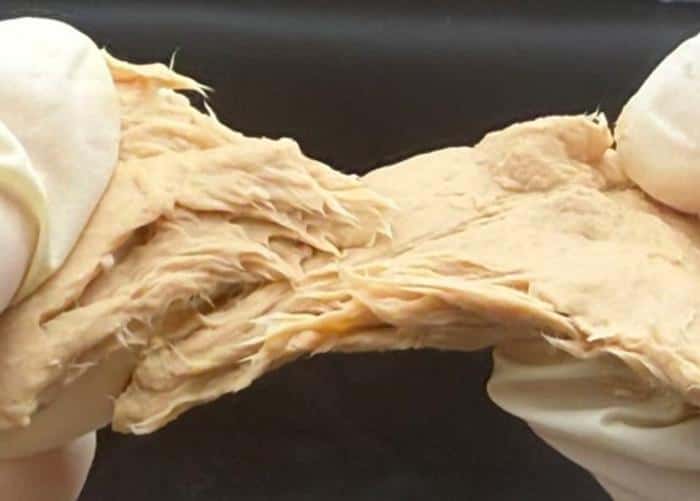 Myco-protein is already used in various commercial products. This new breakthrough could supercharge them. Image via Wiki Commons.
Myco-protein is already used in various commercial products. This new breakthrough could supercharge them. Image via Wiki Commons.
We have a meat problem. We love eating it, but our planet hates producing it. Animal agriculture consumes vast amounts of water, takes up a lot of land, and emits greenhouse gases into an atmosphere that can barely absorb any more. Pound for pound and calorie for calorie, meat is one of the worst types of food for the environment.
Scientists are working on all sorts of possible solutions: burgers grown in petri dishes or plant pastes that bleed like beef. But a new revolution might be grown in a fermentation tank.
A breakthrough study has just supercharged Fusarium venenatum (the fungus used in mycoprotein products like Quorn), turning it into a nutritional powerhouse that puts even chicken to shame.
Building a Better Fungus
“There is a popular demand for better and more sustainable protein for food,” says corresponding author Xiao Liu of Jiangnan University in Wuxi, China. Liu and colleagues set out to tweak an already-used fungus. But they didn’t introduce any foreign DNA. Instead, they used the molecular scissors known as CRISPR/Cas9 to perform a “scarless” gene edit. Technically speaking, it’s not even a GMO product.
Its genes were tweaked, sure. The scientists used CRISPR/Cas9 to simply remove (or “knock out”) specific genes already present in the fungus’s own DNA. But because the changes mimic natural mutations that could theoretically happen (just much faster), the US regulatory agencies do not currently require the testing or labeling mandated for traditional GMOs.
The research team targeted two specific areas in the fungus’s genome. First, they knocked out genes responsible for building thick, hard-to-digest cell walls made of chitin. Second, they tweaked how the fungus processes carbon. The result, a strain named FCPD, is leaner, meaner, and significantly more edible.
 A picture of Fusarium venenatum. Image credits: Xiao Liu.
A picture of Fusarium venenatum. Image credits: Xiao Liu.
By thinning out those cell walls, the researchers made the protein inside much easier for our bodies to access. The new strain boasts a 32.9% increase in its essential amino acid index — the metric that determines how good a protein actually is for human nutrition.
Faster and More Efficient
Standard mycoprotein (protein from mushrooms) is already pretty sustainable compared to beef, but it still requires a lot of sugar (glucose) to grow. This new type of mushroom, however, is a metabolic marvel. It grows 88.4% faster than its wild cousin and, crucially, requires 44.3% less sugar to produce the same amount of biomass.
Because the fungus eats less, we need less land to grow the crops that feed it. The study’s Life Cycle Assessment, which calculates the total environmental cost of a product, shows that this new strain reduces Global Warming Potential by up to 61% compared to the wild type, depending on where it’s produced. But, of course, its most important features are its nutritional ones.
When you stack this mushroom against other proteins, the results are stunning. It is cleaner and greener than chicken, the meat industry’s “efficiency” gold standard. Pork and beef are much worse for the environment than chicken, and in many regards, also less healthy. Even more surprisingly, it absolutely crushes cell-cultured meat (lab-grown meat) in sustainability metrics. Growing meat cells in a lab is incredibly energy-intensive; growing this fungus is not.
“A lot of people thought growing mycoprotein was more sustainable, but no one had really considered how to reduce the environmental impact of the entire production process, especially when compared to other alternative protein products” says first author, Xiaohui Wu of Jiangnan University.
Would People Eat It?
The researchers also ran safety tests. Often, when you mess with fungi, you worry about mycotoxins — nasty byproducts that can make you sick. There was nothing of this sort in the new type of mushrooms. It’s clean, safe, and ready for the dinner table. Its taste is also very similar to meat. To make it even better, studies have shown that swapping red meat for mycoprotein could greatly reduce cardiovascular problems.
However, people are often reluctant to try out GMO foods. The good news is that this doesn’t qualify as a GMO food. Instead, this is more like selective breeding on steroids. For millennia, farmers have cross-bred crops, hoping for a lucky mutation that yields bigger fruit or stronger stalks. This new method just removes the element of luck by precisely snipping out specific genes without adding a single strand of foreign DNA.
This means the mycoprotein could theoretically hit supermarket shelves relatively quickly, at least in the US. The situation is more complex globally, particularly in Europe, where regulations have historically lagged behind the technology.
It’s always possible that this product gets the same GMO stigma and consumers simply don’t want it. But it’s more important than ever to truly consider our options.
Realistically, we are running out of planet. To feed a population sprinting toward 10 billion, we need protein that doesn’t require clear-cutting rainforests or pumping the atmosphere full of methane. While tech bros bet on lab-grown beef that still costs a lot to produce, the real revolution may be happening in a fermentation tank.
The study was published in Trends in Biotechnology.
